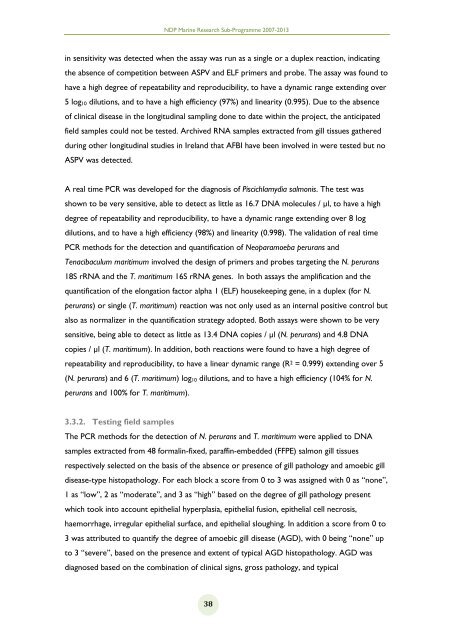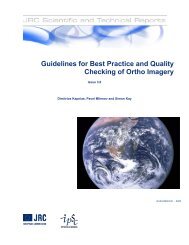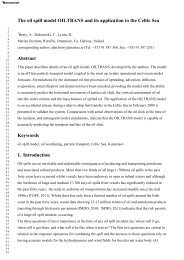No. 12. GILPAT.pdf - Marine Institute Open Access Repository
No. 12. GILPAT.pdf - Marine Institute Open Access Repository
No. 12. GILPAT.pdf - Marine Institute Open Access Repository
Create successful ePaper yourself
Turn your PDF publications into a flip-book with our unique Google optimized e-Paper software.
NDP <strong>Marine</strong> Research Sub-Programme 2007-2013in sensitivity was detected when the assay was run as a single or a duplex reaction, indicatingthe absence of competition between ASPV and ELF primers and probe. The assay was found tohave a high degree of repeatability and reproducibility, to have a dynamic range extending over5 log 10 dilutions, and to have a high efficiency (97%) and linearity (0.995). Due to the absenceof clinical disease in the longitudinal sampling done to date within the project, the anticipatedfield samples could not be tested. Archived RNA samples extracted from gill tissues gatheredduring other longitudinal studies in Ireland that AFBI have been involved in were tested but noASPV was detected.A real time PCR was developed for the diagnosis of Piscichlamydia salmonis. The test wasshown to be very sensitive, able to detect as little as 16.7 DNA molecules / µl, to have a highdegree of repeatability and reproducibility, to have a dynamic range extending over 8 logdilutions, and to have a high efficiency (98%) and linearity (0.998). The validation of real timePCR methods for the detection and quantification of Neoparamoeba perurans andTenacibaculum maritimum involved the design of primers and probes targeting the N. perurans18S rRNA and the T. maritimum 16S rRNA genes. In both assays the amplification and thequantification of the elongation factor alpha 1 (ELF) housekeeping gene, in a duplex (for N.perurans) or single (T. maritimum) reaction was not only used as an internal positive control butalso as normalizer in the quantification strategy adopted. Both assays were shown to be verysensitive, being able to detect as little as 13.4 DNA copies / µl (N. perurans) and 4.8 DNAcopies / µl (T. maritimum). In addition, both reactions were found to have a high degree ofrepeatability and reproducibility, to have a linear dynamic range (R 2 = 0.999) extending over 5(N. perurans) and 6 (T. maritimum) log 10 dilutions, and to have a high efficiency (104% for N.perurans and 100% for T. maritimum).3.3.2. Testing field samplesThe PCR methods for the detection of N. perurans and T. maritimum were applied to DNAsamples extracted from 48 formalin-fixed, paraffin-embedded (FFPE) salmon gill tissuesrespectively selected on the basis of the absence or presence of gill pathology and amoebic gilldisease-type histopathology. For each block a score from 0 to 3 was assigned with 0 as “none”,1 as “low”, 2 as “moderate”, and 3 as “high” based on the degree of gill pathology presentwhich took into account epithelial hyperplasia, epithelial fusion, epithelial cell necrosis,haemorrhage, irregular epithelial surface, and epithelial sloughing. In addition a score from 0 to3 was attributed to quantify the degree of amoebic gill disease (AGD), with 0 being “none” upto 3 “severe”, based on the presence and extent of typical AGD histopathology. AGD wasdiagnosed based on the combination of clinical signs, gross pathology, and typical38
















